教科版五年级下册英语期末常考点课件 (17张PPT)
文档属性
| 名称 | 教科版五年级下册英语期末常考点课件 (17张PPT) | 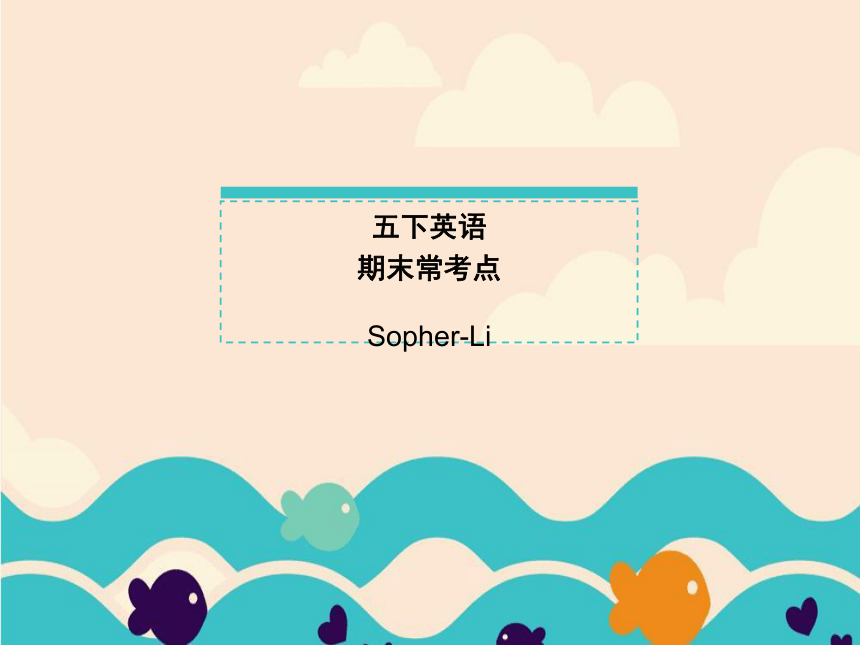 | |
| 格式 | zip | ||
| 文件大小 | 203.1KB | ||
| 资源类型 | 教案 | ||
| 版本资源 | 教科版(广州) | ||
| 科目 | 英语 | ||
| 更新时间 | 2021-06-19 09:05:16 | ||
图片预览

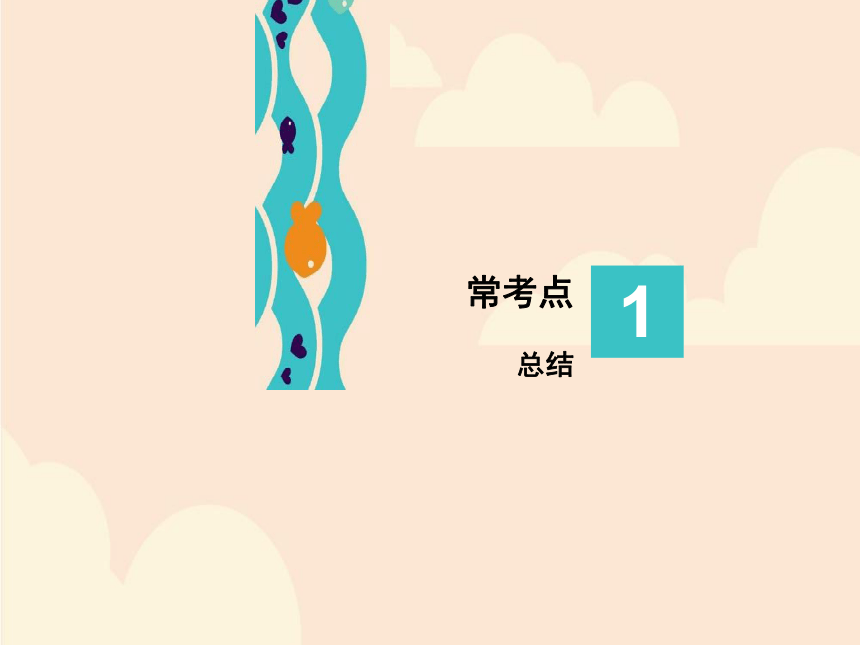
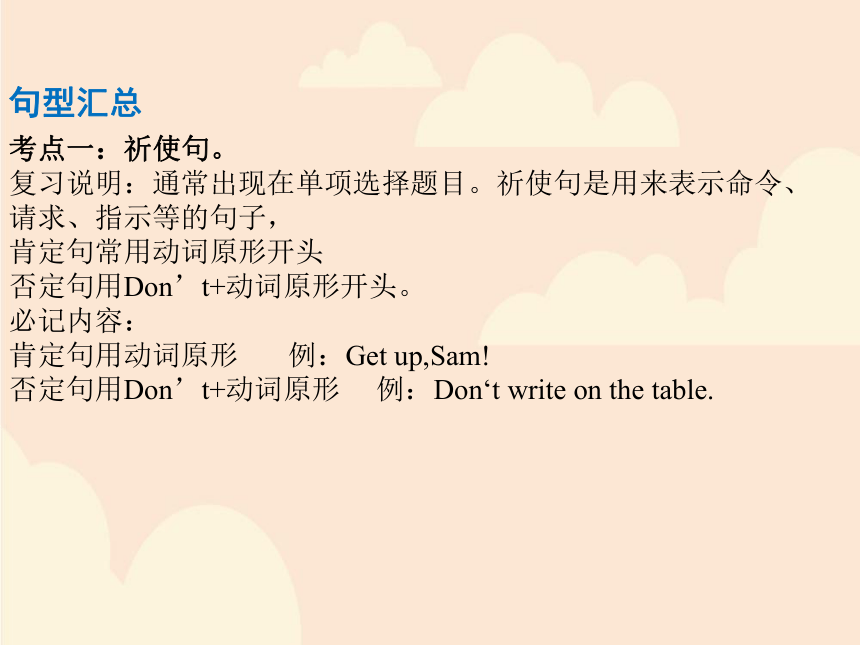
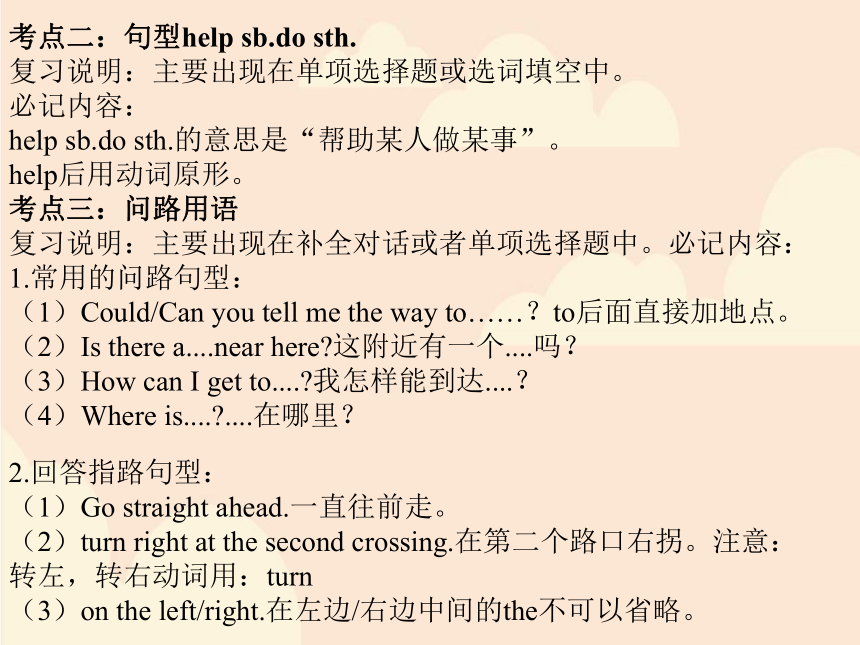
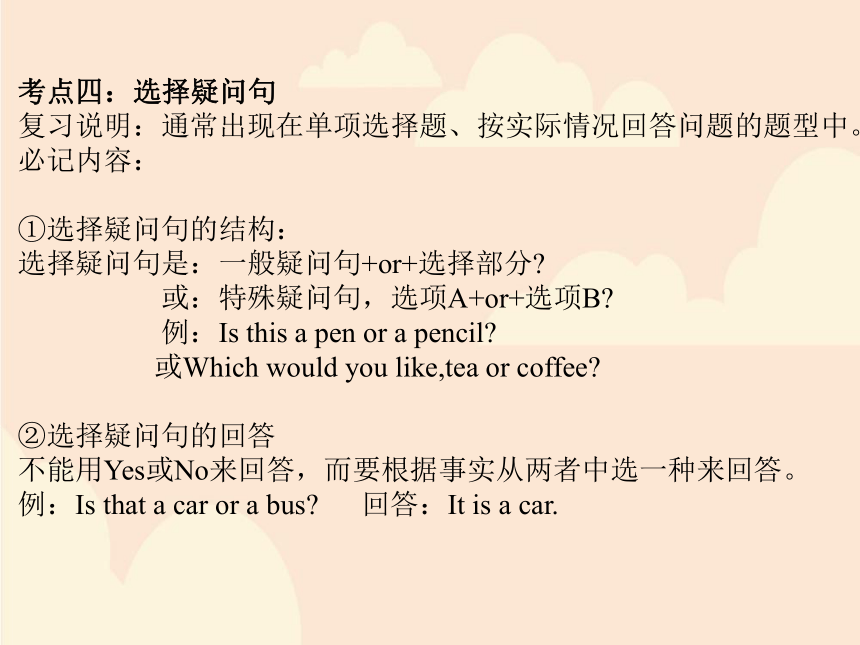
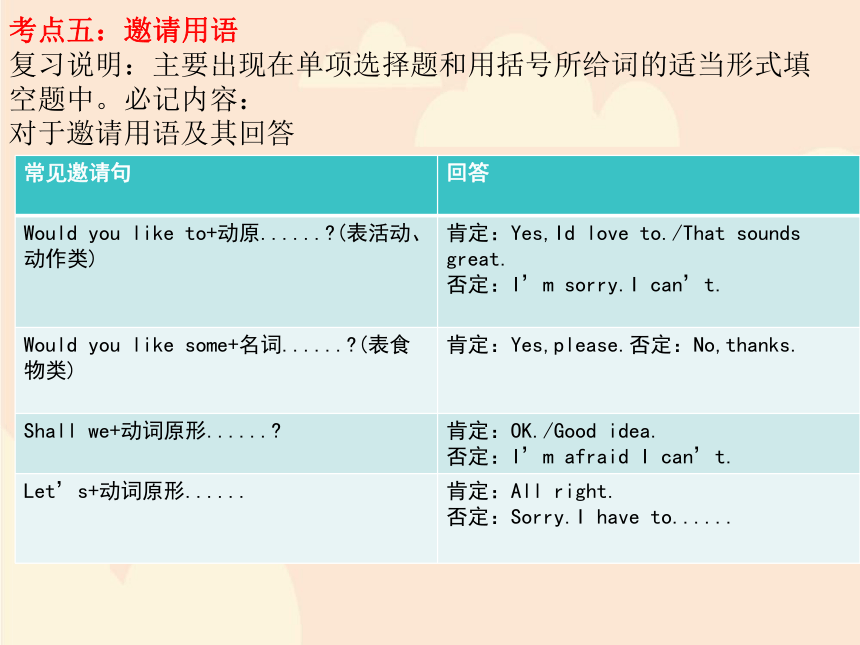

文档简介
(共17张PPT)
五下英语
期末常考点
Sopher-Li
常考点
总结
1
考点一:祈使句。
复习说明:通常出现在单项选择题目。祈使句是用来表示命令、请求、指示等的句子,
肯定句常用动词原形开头
否定句用Don’t+动词原形开头。
必记内容:
肯定句用动词原形
例:Get
up,Sam!
否定句用Don’t+动词原形
例:Don‘t
write
on
the
table.
句型汇总
考点二:句型help
sb.do
sth.
复习说明:主要出现在单项选择题或选词填空中。
必记内容:
help
sb.do
sth.的意思是“帮助某人做某事”。
help后用动词原形。
考点三:问路用语
复习说明:主要出现在补全对话或者单项选择题中。必记内容:
1.常用的问路句型:
(1)Could/Can
you
tell
me
the
way
to……?to后面直接加地点。
(2)Is
there
a....near
here?这附近有一个....吗?
(3)How
can
I
get
to....?我怎样能到达....?
(4)Where
is....?....在哪里?
2.回答指路句型:
(1)Go
straight
ahead.一直往前走。
(2)turn
right
at
the
second
crossing.在第二个路口右拐。注意:转左,转右动词用:turn
(3)on
the
left/right.在左边/右边中间的the不可以省略。
考点四:选择疑问句
复习说明:通常出现在单项选择题、按实际情况回答问题的题型中。必记内容:
①选择疑问句的结构:
选择疑问句是:一般疑问句+or+选择部分?
或:特殊疑问句,选项A+or+选项B?
例:Is
this
a
pen
or
a
pencil?
或Which
would
you
like,tea
or
coffee?
②选择疑问句的回答
不能用Yes或No来回答,而要根据事实从两者中选一种来回答。
例:Is
that
a
car
or
a
bus?
回答:It
is
a
car.
考点五:邀请用语
复习说明:主要出现在单项选择题和用括号所给词的适当形式填空题中。必记内容:
对于邀请用语及其回答
常见邀请句
回答
Would
you
like
to+动原......?(表活动、动作类)
肯定:Yes,Id
love
to./That
sounds
great.
否定:I’m
sorry.I
can’t.
Would
you
like
some+名词......?(表食物类)
肯定:Yes,please.否定:No,thanks.
Shall
we+动词原形......?
肯定:OK./Good
idea.
否定:I’m
afraid
I
can’t.
Let’s+动词原形......
肯定:All
right.
否定:Sorry.I
have
to......
考点六:邀请用用语的运用复习说明:
1.Would
you
like+to
do
something?
提问:Would
you
like
to
go
fishing
with
me
tomorrow?
回答:Yes,I’d
love
to.
/Yes,I‘d
love
to
but
I
don’t
have
time.
1.提问:Would
you
like+something?/Would
you
want/like
some
tea?
回答:Yes,please./No,thanks.
考点七:如何表达自己打算,计划,想要去哪里旅游。
复习说明:
1.will+动词原形
2.be
going+to+动词原形(be动词可包括:is,am,are)
3.plan+to+
动词原形
4.want+to+动词原形
5.would
like+to+动词原形
考点一:一般现在时
1.时间词:every+时间,always,usually,often,sometimes,seldom,never….
2.当主语为非三单,动词用原形。
3.主语为三单是,动词要用第三人称单数,其变化规律如下:
a.直接加s,walk-walks
b.以ch,s,sh,x,o结尾的单词,加es。
watch-watch
c.以辅音字母加y结尾,把y改为i加es。study-studies
d.不规则:have-has
时态汇总
考点二:现在进行时
时间词:now,look,listen,It’s…o’clock.
结构:be(is,am,are)+动词ing
We
are
having
class.
否定句:We
aren’t
having
class.
一般疑问句:
Are
they
having
class?
考点三:一般将来时
复习说明:
1.一般将来时表示打算、即将去做的事情或者可能要发生的事情。
2.时间词:
tomorrow明天
the
day
after
tomorrow后天
next
week/month/year/summer下一周/月/年/夏天
this
afternoon今天下午
this
evening/tonight今天晚上
soon很快
someday将来的某一天
In
the
future将来
in
two
weeks在两周内
before
long不久
later以后
3.两种表现形式
主语+be
going
to+动词原形
/主语+will/shall+动词原形
否定式:
主语+will/shall+not+动词原形+其他/主语+be+not+going
to+动词原形+其他
否定式的缩写形式:won't==will
not
考点四:一般过去时
1.定义:表示在过去的时间内所发生的动作或存在的状态。
2.标志词:
1)yesterday类(昨天):
yesterday,yesterday(morning/afternoon/evening)
2)last类(上一个…):
last
year(去年),last
summer(去年夏天),lastweek
3)ago类(…之前):
three
days
ago(三天前),an
hour
ago(一个小时前)
4)this
morning(今天早上),just
now(刚刚)
3.动词过去式的规则变化:
变化规则示例
1.一般情况下+ed
look–looked
2.以不发音的e结尾+d
live-lived
3.以辅音字母加y结尾,变y为i+edstudy-studied
4.重读闭音(辅元辅),双写尾字母+edstop-stopped
5.不规则变化is/am-were
考点一:like,love,prefer,favourite的区别
复习说明:
通常出现在单项选择题、用所给词的适当形式填空和完形填空,要熟记他们的用法。
必记内容:
like/love+动词ing形式,
prefer
to+动词原形,
favourite表示最喜欢=like…best
语法汇总
考点二:too,either,also的区别
复习说明:
通常出现在单项选择题,做题时要看清楚是肯定,否定还是疑问句式。
必记内容:
1.also:一般用于肯定句,位于句中
2.too:可用于肯定句和一般疑问句,位于句尾
3.either:一般用于否定句,位于句尾
考点三:What
be
like的用法
考点四:for的用法
必记内容:
1.表目的:He
is
visiting
me
for
the
summer
holiday.
2.因为:Thank
you
for
your
help.
3.给:This
present
is
for
you.
考点五:时间介词in、on、at的用法
复习说明:
通常出现在单项选择题、按实际情况回答问题和完形填空中。
必记内容:
(1)in:年、月份、季节、in
the
morning/afternoon/evening
(2)on:几月几日、星期几、on
weekdays
(3)at:几点钟、at
the
weekend、at
noon/night
口诀:in大at小on
考点六:序数词
复习说明:
通常出现在单项选择题和用括号内所给词的适当形式填空题中。
必记内容:
基变序,有规律。
一二三,特殊记,词尾各是t,d,d。first
second
third
th四加起。fourth
sixth
八去t,九去e,f来把ve替,ty变成tie。eighth
ninth
fifth
twentieth
若是遇到几十几,只变各位就可以。thirty-first
the+序数词
考点七:感官动词
复习说明:
通常出现在单项选择题、按实际情况回答问题和完形填空中。
必记内容:
感官动词后面加形容词,表示......
起来怎么样。
听起来:sound
感觉起来:feel
看起来:look
闻起来:smell
尝起来:taste
考点八:动词作主语时,需要使用--ing形式。复习说明:
复习说明:
主要出现在单项选择题中,同学们要熟悉这种句型,动词当主语的时候要用ing形式。
必记内容:Cooking
can
be
fun.
动词作主语要用ing形式。
考点九:介词on的用法
复习说明:
通常出现在单项选择题和选择正确的答案填空的题型中。
必记内容:
(1)表示方向。on
the
left/on
the
right在左边/在右边
(2)表示位置,指两物直接接触,在……上面。on
the
table
(3)表示“凭借;通过;以……方式”。on
the
radio
(4)表示关于。A
book
on
music
(5)放在日期,具体某一天前,表示“在”on
Sunday,on
June
1st
五下英语
期末常考点
Sopher-Li
常考点
总结
1
考点一:祈使句。
复习说明:通常出现在单项选择题目。祈使句是用来表示命令、请求、指示等的句子,
肯定句常用动词原形开头
否定句用Don’t+动词原形开头。
必记内容:
肯定句用动词原形
例:Get
up,Sam!
否定句用Don’t+动词原形
例:Don‘t
write
on
the
table.
句型汇总
考点二:句型help
sb.do
sth.
复习说明:主要出现在单项选择题或选词填空中。
必记内容:
help
sb.do
sth.的意思是“帮助某人做某事”。
help后用动词原形。
考点三:问路用语
复习说明:主要出现在补全对话或者单项选择题中。必记内容:
1.常用的问路句型:
(1)Could/Can
you
tell
me
the
way
to……?to后面直接加地点。
(2)Is
there
a....near
here?这附近有一个....吗?
(3)How
can
I
get
to....?我怎样能到达....?
(4)Where
is....?....在哪里?
2.回答指路句型:
(1)Go
straight
ahead.一直往前走。
(2)turn
right
at
the
second
crossing.在第二个路口右拐。注意:转左,转右动词用:turn
(3)on
the
left/right.在左边/右边中间的the不可以省略。
考点四:选择疑问句
复习说明:通常出现在单项选择题、按实际情况回答问题的题型中。必记内容:
①选择疑问句的结构:
选择疑问句是:一般疑问句+or+选择部分?
或:特殊疑问句,选项A+or+选项B?
例:Is
this
a
pen
or
a
pencil?
或Which
would
you
like,tea
or
coffee?
②选择疑问句的回答
不能用Yes或No来回答,而要根据事实从两者中选一种来回答。
例:Is
that
a
car
or
a
bus?
回答:It
is
a
car.
考点五:邀请用语
复习说明:主要出现在单项选择题和用括号所给词的适当形式填空题中。必记内容:
对于邀请用语及其回答
常见邀请句
回答
Would
you
like
to+动原......?(表活动、动作类)
肯定:Yes,Id
love
to./That
sounds
great.
否定:I’m
sorry.I
can’t.
Would
you
like
some+名词......?(表食物类)
肯定:Yes,please.否定:No,thanks.
Shall
we+动词原形......?
肯定:OK./Good
idea.
否定:I’m
afraid
I
can’t.
Let’s+动词原形......
肯定:All
right.
否定:Sorry.I
have
to......
考点六:邀请用用语的运用复习说明:
1.Would
you
like+to
do
something?
提问:Would
you
like
to
go
fishing
with
me
tomorrow?
回答:Yes,I’d
love
to.
/Yes,I‘d
love
to
but
I
don’t
have
time.
1.提问:Would
you
like+something?/Would
you
want/like
some
tea?
回答:Yes,please./No,thanks.
考点七:如何表达自己打算,计划,想要去哪里旅游。
复习说明:
1.will+动词原形
2.be
going+to+动词原形(be动词可包括:is,am,are)
3.plan+to+
动词原形
4.want+to+动词原形
5.would
like+to+动词原形
考点一:一般现在时
1.时间词:every+时间,always,usually,often,sometimes,seldom,never….
2.当主语为非三单,动词用原形。
3.主语为三单是,动词要用第三人称单数,其变化规律如下:
a.直接加s,walk-walks
b.以ch,s,sh,x,o结尾的单词,加es。
watch-watch
c.以辅音字母加y结尾,把y改为i加es。study-studies
d.不规则:have-has
时态汇总
考点二:现在进行时
时间词:now,look,listen,It’s…o’clock.
结构:be(is,am,are)+动词ing
We
are
having
class.
否定句:We
aren’t
having
class.
一般疑问句:
Are
they
having
class?
考点三:一般将来时
复习说明:
1.一般将来时表示打算、即将去做的事情或者可能要发生的事情。
2.时间词:
tomorrow明天
the
day
after
tomorrow后天
next
week/month/year/summer下一周/月/年/夏天
this
afternoon今天下午
this
evening/tonight今天晚上
soon很快
someday将来的某一天
In
the
future将来
in
two
weeks在两周内
before
long不久
later以后
3.两种表现形式
主语+be
going
to+动词原形
/主语+will/shall+动词原形
否定式:
主语+will/shall+not+动词原形+其他/主语+be+not+going
to+动词原形+其他
否定式的缩写形式:won't==will
not
考点四:一般过去时
1.定义:表示在过去的时间内所发生的动作或存在的状态。
2.标志词:
1)yesterday类(昨天):
yesterday,yesterday(morning/afternoon/evening)
2)last类(上一个…):
last
year(去年),last
summer(去年夏天),lastweek
3)ago类(…之前):
three
days
ago(三天前),an
hour
ago(一个小时前)
4)this
morning(今天早上),just
now(刚刚)
3.动词过去式的规则变化:
变化规则示例
1.一般情况下+ed
look–looked
2.以不发音的e结尾+d
live-lived
3.以辅音字母加y结尾,变y为i+edstudy-studied
4.重读闭音(辅元辅),双写尾字母+edstop-stopped
5.不规则变化is/am-were
考点一:like,love,prefer,favourite的区别
复习说明:
通常出现在单项选择题、用所给词的适当形式填空和完形填空,要熟记他们的用法。
必记内容:
like/love+动词ing形式,
prefer
to+动词原形,
favourite表示最喜欢=like…best
语法汇总
考点二:too,either,also的区别
复习说明:
通常出现在单项选择题,做题时要看清楚是肯定,否定还是疑问句式。
必记内容:
1.also:一般用于肯定句,位于句中
2.too:可用于肯定句和一般疑问句,位于句尾
3.either:一般用于否定句,位于句尾
考点三:What
be
like的用法
考点四:for的用法
必记内容:
1.表目的:He
is
visiting
me
for
the
summer
holiday.
2.因为:Thank
you
for
your
help.
3.给:This
present
is
for
you.
考点五:时间介词in、on、at的用法
复习说明:
通常出现在单项选择题、按实际情况回答问题和完形填空中。
必记内容:
(1)in:年、月份、季节、in
the
morning/afternoon/evening
(2)on:几月几日、星期几、on
weekdays
(3)at:几点钟、at
the
weekend、at
noon/night
口诀:in大at小on
考点六:序数词
复习说明:
通常出现在单项选择题和用括号内所给词的适当形式填空题中。
必记内容:
基变序,有规律。
一二三,特殊记,词尾各是t,d,d。first
second
third
th四加起。fourth
sixth
八去t,九去e,f来把ve替,ty变成tie。eighth
ninth
fifth
twentieth
若是遇到几十几,只变各位就可以。thirty-first
the+序数词
考点七:感官动词
复习说明:
通常出现在单项选择题、按实际情况回答问题和完形填空中。
必记内容:
感官动词后面加形容词,表示......
起来怎么样。
听起来:sound
感觉起来:feel
看起来:look
闻起来:smell
尝起来:taste
考点八:动词作主语时,需要使用--ing形式。复习说明:
复习说明:
主要出现在单项选择题中,同学们要熟悉这种句型,动词当主语的时候要用ing形式。
必记内容:Cooking
can
be
fun.
动词作主语要用ing形式。
考点九:介词on的用法
复习说明:
通常出现在单项选择题和选择正确的答案填空的题型中。
必记内容:
(1)表示方向。on
the
left/on
the
right在左边/在右边
(2)表示位置,指两物直接接触,在……上面。on
the
table
(3)表示“凭借;通过;以……方式”。on
the
radio
(4)表示关于。A
book
on
music
(5)放在日期,具体某一天前,表示“在”on
Sunday,on
June
1st
同课章节目录
